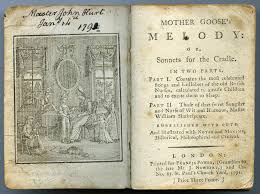Mother Goose’s Mysterious Melodies
Listen to the Recess! Clip
| Author | Rita Smith |
| Air Date | 12/18/2001 |

Mother Goose’s Mysterious Melodies Transcript
December 18, 1719: Thomas Fleet of Boston publishes Songs for the Nursery, or Mother Goose’s Melodies. You can find this bold statement in various almanacs and daily calendars and, if this is true, this publication would be the first mention of Mother Goose as a creator of nursery rhymes, predating any similar English book.
The story of this publication goes like this: A young girl from Charleston, Elizabeth Foster, married a widower from Boston, Isaac Goose (or was it Vergoose?), who already had 10 children. They had six (some say 4) more of their own. One of their children, Elizabeth, married Thomas Fleet, a Boston printer. Thomas and Elizabeth had six children of their own and their maternal grandmother, who lived with them, spent her days in the nursery and around the house pouring forth, in unmelodious strains, an abundance of rhymes for the amusement of the Fleet children, greatly to the annoyance of the whole neighborhood and of Thomas Fleet in particular. She must have had an exceptionally loud grating voice and Thomas Fleet was a man who loved a little peace and quiet. He tried for a long time, by every means in his power, the story goes, to put an end to this singing; but his mother-in-law would not be silenced. Finally, he wrote down her songs and published them in 1719, supposedly somewhat as a joke, since her tunes apparently were anything but “melodies” or “melodious.”
Some sources and scholars claim there is reasonable support for this story; that indeed, Elizabeth Goose did sing to her grandchildren and that Thomas Fleet did print this book, thereby making Mother Goose American in origin, and not British. Another source states that the book was popular and made Fleet a lot of money.1
But the Oxford Companion to Children’s Literature says “Not so fast, my friend,” and suggests that “American affection for Mother Goose seems to have given rise to a strange piece of invented history.”2 This story was instigated in 1860 by a descendant of Fleet, who claimed that a researcher told him he had seen a fragment of this book in the library of the American Antiquarian Society. In spite of a thorough search of the library’s catalogue and stacks, no such volume was ever mentioned or found. Repeated advertisements and researches by the Society failed to bring it to light and no other copy has ever been found anywhere. It is a mystery, a bibliographic mystery, whether the book was ever actually printed and Songs for the Nursery, or Mother Goose’s Melodies, published by Thomas Fleet in 1719, remains one of those “elusive ‘ghost’ volumes in the history of American letters.”3
1 http://famousamericans.net/thomasfleet/
2 Oxford Companion To Children’s Literature, p. 362.
3 The Annotated Mother Goose, p. 18
Sources:
Baring-Gould, William S. and Ceil Baring-Gould, The Annotated Mother Goose: Nursery Rhymes Old and New. New York: Bramhall House, 1962
Carpenter, Humphrey andMari Prichare, eds., The Oxford Companion to Children’s Literature. Oxford: Oxford University Press, 1984.
Website: http://famousamericans.net/thomasfleet/